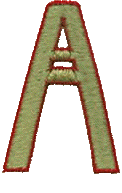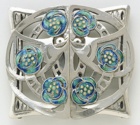 Arts and Crafts Movement - A predominantly English art
movement during the last half of the nineteenth century to
reassert the importance of finely designed
and made object in the face
of increasing industrialization and mass-production.
Arts and Crafts Movement - A predominantly English art
movement during the last half of the nineteenth century to
reassert the importance of finely designed
and made object in the face
of increasing industrialization and mass-production.
It was most strongly driven by William Morris (English, 1834-1896).
One of the leading architects involved was Charles Rennie Mackintosh (Scottish, 1868-1928).
Examples:

William Morris and Co. (England, Surrey,
the Merton Abbey Works), The Adoration of the Magi Tapestry, late
19th century, wool, handwoven, 255 x 379 cm, Hermitage Museum,
St. Petersburg, Russia. In the 1880s William Morris attempted
to revive tapestry
weaving, along with fine hand-printing of books,
furniture
making, and other crafts.

William Morris (English, 1834-1896), Guinevere and Iseult: Cartoon for Stained Glass,
1862, chalk, pencil and watercolor on paper,
61.0 x 685 cm, Tate Gallery, London. See cartoon and stained glass.

William Morris and the Merton Abbey Works,
Surrey, Evenlode, 1883-1900, printed cotton,
50 x 66 1/2 inches (127 x 168.9 cm), Cincinnati Art Museum, OH.
This pattern was "derived from Persian and seventeenth-century
Italian velvets and is a masterpiece
of indigo discharge. The printing of this pattern involved the
use of 33 different printing blocks. The dark green background
alone required dyeing the cloth blue and overprinting with a
strong yellow. This floral pattern is a complex series of printing
resists, which kept dye from penetrating the fabric; printing
dye, which gave the fabric color; and discharges, which lifted
color out of the fabric."

William Morris, Angel of the Resurrection: Cartoon for Stained
Glass, 1862, crayon,
pencil and watercolor on paper,
68.9 x 46.5 cm, Tate Gallery, London.

William Morris, Pink and Rose Wallpaper Design, c. 1890,
hand-block-printed wallpaper, 22 x 28 inches (55.9
x 71.1 cm), Metropolitan Museum of Art, NY.

Designed by William Morris, made/manufactured
by Morris and Company, Merton Abbey, England, Length of Printed Cotton, 19th-20th century,
cotton, 8 feet 7 1/2 x 38 1/4 inches (262.9 x 97.2 cm), Metropolitan
Museum of Art, NY. See textile.

William Morris, Design for Tapestry, drawing
on paper, 13.3 x 34.9 cm, Tate
Gallery, London. See tapestry.

Charles Rennie Mackintosh (Scottish, 1868-1928),
designer, Washstand, 1904, oak, ceramic
tile, leaded colored glass and mirror
glass, 63 1/4 x 51 1/4 x 20 3/8 inches (160.7 x 130.2 x 51.8
cm), Metropolitan Museum of Art, NY.

Charles Rennie Mackintosh, Hill House Chair, 1904, black lacquered wood with upholstered seat, 55 x 16 x 14 1/4 inches.
![]()

Charles Rennie Mackintosh, designer, Domino Clock, c. 1917, wood,
ebony, ivory, erinoid
(brand of polyvinyl chloride
(PVC)), Glasgow Museums. See Arts
and Crafts Movement and Scottish
art.

Jessie M. King (English, 1875-1949) for Liberty & Company, Buckle, 1913, silver and enamel, 2 1/4 x 2 inches (5.71 x 5.08 cm), Los angeles County Museum of Art.
Also see Art Deco, Art Nouveau, English art, furniture, and Pre-Raphaelite Brotherhood.
https://inform.quest/_art
Copyright © 1996-![]()